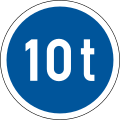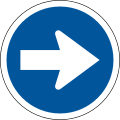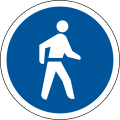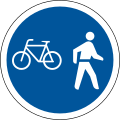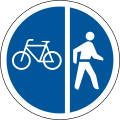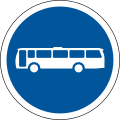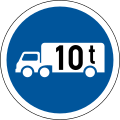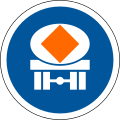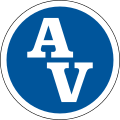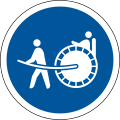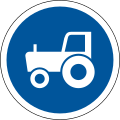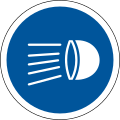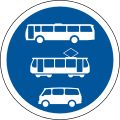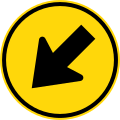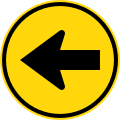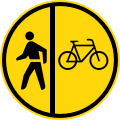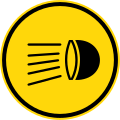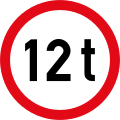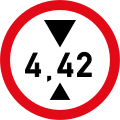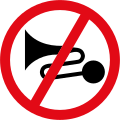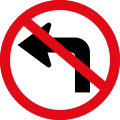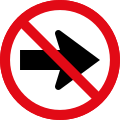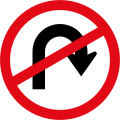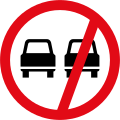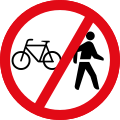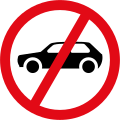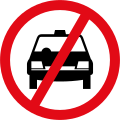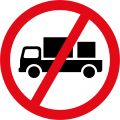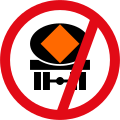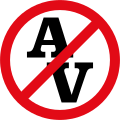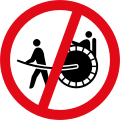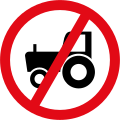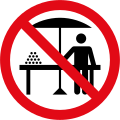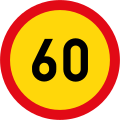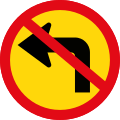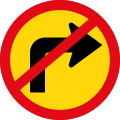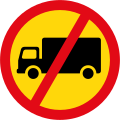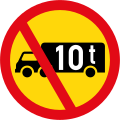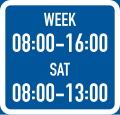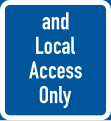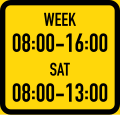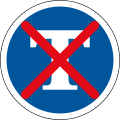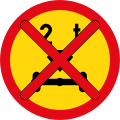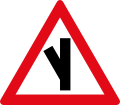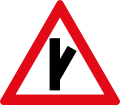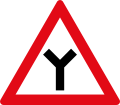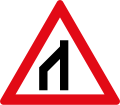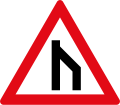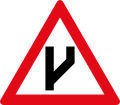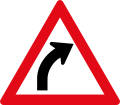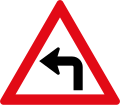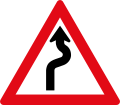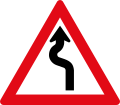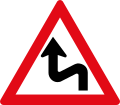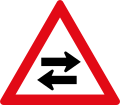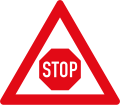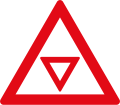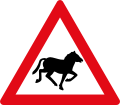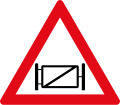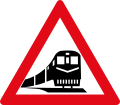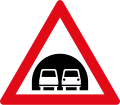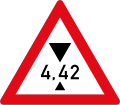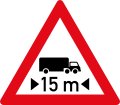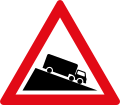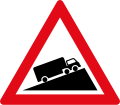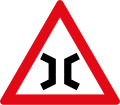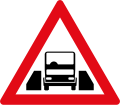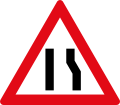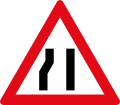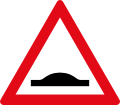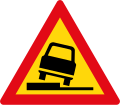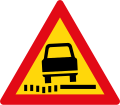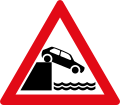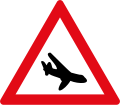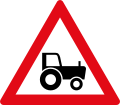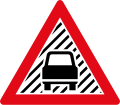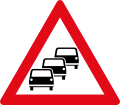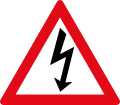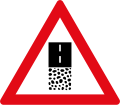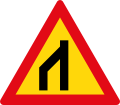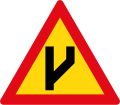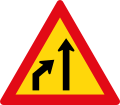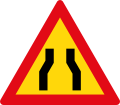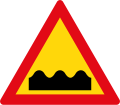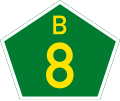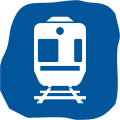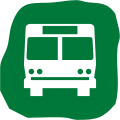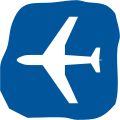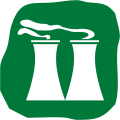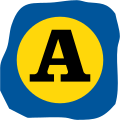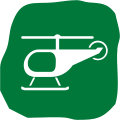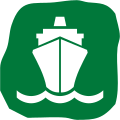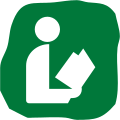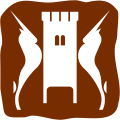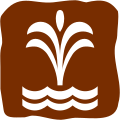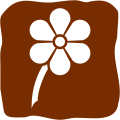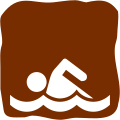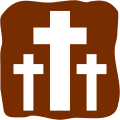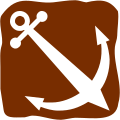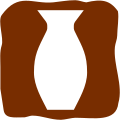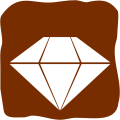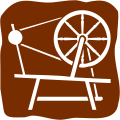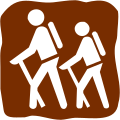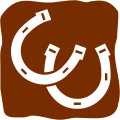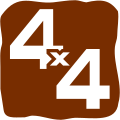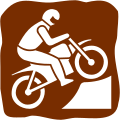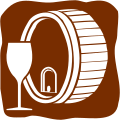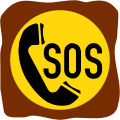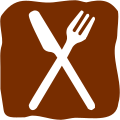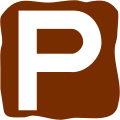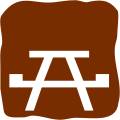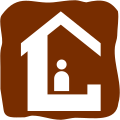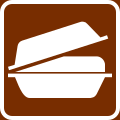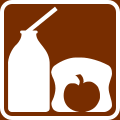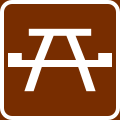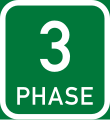Illustration of the road signs in Namibia
The picture board of the road signs in Namibia shows a selection of important road signs in Namibia . They are regulated in the Road Traffic and Transport Act, 1999 (RTaTA) . They largely correspond to the requirements of the Development Community of Southern Africa (SADC).
General
The Road Traffic and Transport Act, 1999 (RTaTA) describes two basic types of traffic signs, a standard version and a temporary version. The standard version is available with different skin color components, e.g. B. blue or white and is a standard series z. B. with the index W ... or R ... assigned. These are permanently erected traffic signs that are permanently installed.
The temporary traffic signs can be found e.g. B. in the signage of construction sites use. There are temporarily placed characters with yellow skin color components, which correspond to the usual standard version and the index of the standard series is preceded by a T (e.g. TW ... or TR ... etc.). Temporary traffic signs are not always based on a standard version if they are only set up for a short time (e.g. at an accident site or during a traffic control).
The following structure of the categories is based on the traffic sign catalog of Annex 2 Class I of the RTaTA published on February 15, 2019. The traffic signs marked with an * (asterisk) are described in the RTaTA, but are not currently (as of July 2019) in Namibia set up.
Regulatory traffic signs according to Annex 2 RTaTA
The regulatory traffic signs are divided into groups A to I according to their function. These groups are divided up so that they can be used to assign new traffic signs. The RTaTA describes a combination of shapes and color variants in order to be able to differentiate between the individual groups.
Group A: priority characters
R1: Stop! Give way
R1.5: Stop / Go sign for manual traffic regulation (similar to the winker trowel )
R2: right of way grant
R2.1: pedestrian crossing
R4.1: one-way street - pointing left
Group B: mandatory signs
R101: Prescribed minimum speed
R110: sidewalk *
R111: cycle path
R116: Motorcycles only
R117: Passenger cars only
R118: Taxis only
R119: Minibuses only *
R120: Midibuses only *
R121: buses only *
R122: Only vans *
R123: Only trucks *
R128: Rickshaws only *
R129: coaches only *
R131: Only team wagons *
R132: Toll Route (T oll ) *
R137: roundabout
R138: Only trams *
Examples of temporary mandatory signs:
TR116: Motorcycles only *
TR117: Passenger cars only
Group C: Prohibition signs
R207: Hitchhiking prohibited
R216: Restricted no parking ( parking )
R217: Absolute no stopping (S topping )
R240: Prohibition for trailers or attached vehicles *
R241: Ban on street trading
Examples of temporary prohibition signs:
TR216: Restricted no parking ( parking )
TR217: Absolute stop prohibition (S topping )
Group D1: Special lanes and traffic areas
R302: bus lane *
R320: traffic area reserved for vehicles from car-pooling *
R322: traffic area reserved for emergency vehicles *
R324: Traffic area reserved for vehicles with severely disabled people *
R325: traffic area reserved for authorized vehicles
R326: bus stop *
Special forms
As a special form in group D1 there is a regularly used traffic sign for the bus stops in the city of Windhoek. The symbol not described in the RTaTA contains, as additional information in the white oval, details of the means of transport (e.g. B for bus) and the number of the stop (e.g. 13). The reason for this is that there is no traditional local public transport in Windhoek , but rather a small number of commuter buses with low frequency of the Windhoek Bus Service .
Examples of temporary special lanes and traffic areas:
TR302: bus lane *
Group D2: parking areas
Examples of temporary parking areas:
Group E: traffic zones
The RTaTA does not provide for a temporary variant for group E traffic signs.
Group F: Additional signs for regulatory road signs
According to the RTaTA, the additional signs of group F may only be used for regulatory traffic signs and their shape and color must be adapted. Thus, of all additional characters in the standard version, there is a variant in black and white with a red border and a variant in blue and white. The temporary version described the RTaTA as black and yellow with a red border or exclusively black and yellow, depending on the application. In the following all additional characters of group F are exemplified in the different colors of the standard version:
Examples of temporary additional characters:
Group G: cancellation sign
A group G cancellation sign indicates that the instruction, prohibition and directive under the red cross has been canceled. Here are some examples:
Examples of temporary cancellation characters:
Group H: Application examples of additional characters of group F
Application examples for temporary additional characters:
Group I: Application examples of general additional symbols
Hazard signs according to Annex 2 RTaTA
The hazard signs are divided into groups A to C according to their function. They can indicate an immediate danger or a potential danger. The RTaTA writes a triangular shape with a red border and a black symbol for all danger signs.
Group A1: Advance notice of a danger from further traffic routes
W101: intersection
W116: End of the separate carriageways , merging from the left
Group A2: Advance notice of a danger due to changing course of the road
W206: hairpin curve (right)
W208: Serpentine (starting on the right)
W212: two-way traffic
Group A3: Advance notice of a danger zone
W301: traffic light system
TW304: traffic control
TW305: student guide
W310: Cattle Drive - Cattle
W313: Wildwechsel
W314: Gate
W315: cattle grate on the right
W325: start of a gravel road
W332: Speed bumps
TW337: grading work
W350: sink filled with water / loose material
W356: rider
W357: Deer crossing - elephants
W358: Deer crossing - warthogs
W359: Wild Crossing - Hippos
W361: Electric overhead line *
Examples of group A temporary characters:
TW116: End of separate carriageways , merging from the left
TW212: two-way traffic
Group B: transport facilities
W403: level crossing with one track
W415: horizontal guide mark
Examples of temporary transport facilities:
Group C: Combined warning signs
Special forms and historical danger signs
Deer crossing - ( Beach Wolf )
Deer crossing - ( Leopard )
Deer crossing - ( Oryx )
Orientation signs according to Annex 2 RTaTA
The orientation signs are divided into groups A to G according to their function. According to the RTaTA, orientation signs are an essential part of safe navigation on public roads. They should offer a uniform appearance and inform road users about the classification of the road using the basic color (e.g. blue for the motorway). There are only a few temporary variants of orientation signs.
Group A: Location signs
Symbols for use on location signs
The symbol is always associated with a designation or a name (e.g. the name of a body of water).
Group B: route markings
Group C: Signpost
Symbols for destinations with increased traffic significance
Group D: Motorway signposts
Group E: Guide to tourist destinations
GF13: Emergency telephone *
Symbols of destinations with tourist traffic significance
The following symbols are to be used on signposts or tourist information boards for orientation and information. According to the RTaTA, each symbol is assigned to a group of related symbols.
Nature reserves
A1: National Park *
Recreation and leisure
A3-2: thermal spring
A3-5: mountain *
Natural landscapes
A4: Beautiful natural landscape
A4-1: nature reserve *
A4-2: Natural heritage *
A4-3: Botanical Garden *
A4-5: waterfall *
A4-6: lake or dam (no water sports) *
A4-7: caves *
A4-8: lookout point
A4-9: forest (naturally grown) *
A4-10: State forest *
Sports facilities
A5-1: Motorsport racetrack *
A5-2: golf course
A5-3: Racecourse *
A5-4: horse show *
A5-5: Fishing *
A5-6: cricket field *
A5-7: swimming pool *
A5-8: Stadium *
Wildlife park and protected areas
A6: Wildlife Park *
A6-1: wildlife sanctuary *
A6-2: game reserve *
A6-3: bird park or bird sanctuary *
A6-4: Zoological garden *
A6-5: Wildlife Park ( snakes ) *
A6-6: Wildlife Park ( crocodiles ) *
A6-7: Wildlife Park ( rhinos ) *
A6-8: Wildlife Park ( Lions ) *
Historical sights
A7: historical place *
A7-1: National Monument
A7-2: Museum
A7-3: Historic mine *
A7-4: Historic train station *
A7-5: Historic battlefield *
A7-6: Historic cemetery
A7-7: Geological site *
Coastal attractions
A8-1: Marine reserve *
A8-2: Maritime Museum *
A8-3: Aquarium *
A8-4: whales *
A8-5: Dolphins *
A8-6: lighthouse *
A8-7: Shipyard *
A8-8: slipway
A8-9: fishing
A8-10: Lobsters and crustaceans *
A8-11: Ozeaneum *
Arts and crafts
A9: arts and crafts
A9-2: Pottery *
A9-3: Jewelry and precious stones *
A9-5: Leather goods *
A9-6: African arts and crafts *
A9-7: carpenter or carpenter *
A9-8: (Art) blacksmiths *
A9-9: sculpture *
Culture
A10: Culture and cultural institution *
A10-1: theater
A10-2: Amphitheater *
Adventure and experiences
A11: Adventure and Experience *
A11-1: hiking trail
A11-2: Trail riding (horse trail) *
A11-3: cross-country drive (off-road trail) *
A11-5: river or white water rafting *
A11-6: Scuba diving *
A11-7: ballooning *
Agriculture
A12: Agriculture *
A12-1: Winery *
A12-2: Wine Route or Winery *
A12-3: Event or Exhibition Center *
A12-4: Cherry plantation *
A12-5: ostrich breeding and ostrich riding *
A12-7: aquaculture
A12-8: street stall *
A12-9: butterfly farming *
General attractions
A13: General attractions *
A13-1: Theme park *
Symbols for the goals of service centers and offices with traffic significance
Emergency services
B1-1: telephone
B1-3: hospital (by name)
B1-4: First aid *
B1-5: Emergency telephone (symbol on the traffic sign) *
B1-7: rescue (S ea R Escue I nstitute of N amibia ) *
B1-9: Fire brigade and fire station *
B1-10: emergency number
Vehicle service
B2-1: Petrol station and roadside assistance *
B2-4: Towing service *
Truck service
Gastronomy and local supply
B4-3: Snack stand *
B4-4: market stall , kiosk , café or grocer *
General service
B5-2: toilets *
B5-3: shower *
B5-4: drinking water
B5-5: barbecue area
B5-7: picnic tables
B5-8: tourist information
B5-11: Post office *
B5-12: shop *
Resting places
Vehicle types
B7-2: caravan
Accommodation
C1-1: Overnight stay (including hotels, inns, etc.)
C1-2: holiday home *
C1-3: campsite
C1-4: campsite
C1-5: Guesthouse *
C1-6: Bed and Breakfast *
C1-7: guest room (only overnight stay)
C1-8: youth hostel , youth center or tent camp *
C1-9: Overnight stay ( Trail Shelter) *
C1-10: guest farm
Symbols on information boards of rest stops
D1-23: car wash *
Group F: Guide to local destinations
Symbols for destinations with significant traffic significance
GDLS-A1-1: Business Center
GDLS-A1-2: University
GDLS-A1-3: Technical University
GDLS-A1-4: educational institution or university
GDLS-A1-5: shopping center
GDLS-A1-6: Train station *
GDLS-A1-7: Airport
GDLS-A1-8: bus stop
GDLS-A1-10: port
GDLS-A1-12: Parking garage *
GDLS-A1-13: switch node *
Symbols for destinations with traffic significance
GDLS-A2-4: industrial area
GDLS-A2-5: Parking and Travel
GDLS-A2-6: Landfill
GDLS-A2-7: Fresh produce market
GDLS-A2-11: power plant
GDLS-A2-13: library
GDLS-A2-14: swimming pool
Symbols for points of interest with traffic significance
GDLS-A3-4: Broadcasting station
GDLS-A3-5: Autokino
GDLS-A3-6: Nursery
GDLS-A3-8: Road Traffic Office
GDLS-A3-9: Energy supplier
Symbols for the goals of emergency and aid services
GDLS-A4-6: Tierschutzverein ( SPCA - Society for the Prevention of Cruelty to Animals)
Group G: traffic control panels
Information signs according to Annex 2 RTaTA
The RTaTA does not provide for a grouping of the reference signs, but can be divided into the groups general and additional signs . Note signs are all signs that do not fall under the preceding categories. The RTaTA recommends the rectangular shape, but prohibits circular or triangular characters. The basic color for new characters should be green in the standard version and yellow in the temporary variant. An exception are the additional characters, the shape and color of which depend on the respective main character.
General information signs
IN9: Parking and traveling by bus *
IN14: Green wave at 55 km / h *
Examples of temporary signs:
Additional characters
The following additional signs are always in connection with a higher-level traffic sign. The RTaTA does not allow a single list. A symbol should always be used instead of verbal information.
Indication through verbal information:
The additional character IN11.4 or TIN11.4 contains a reference text as information. The RTaTA allows the free assignment of a text or keyword for this symbol :
Note through symbols:
The additional symbol IN11.5 or TIN5.11 contains a note symbol as information. The RTaTA initially describes the use of a free symbol, but defines the symbols that can be used in the IN11.500 series:
Below are the symbols to be used after the RTaTA:
IN11.506: Additional characters - radar control
See also
Web links
- Road Traffic and Transport Act, 22 of 1999. (English)
- Road Traffic and Transport Regulations, 2001. (English)















